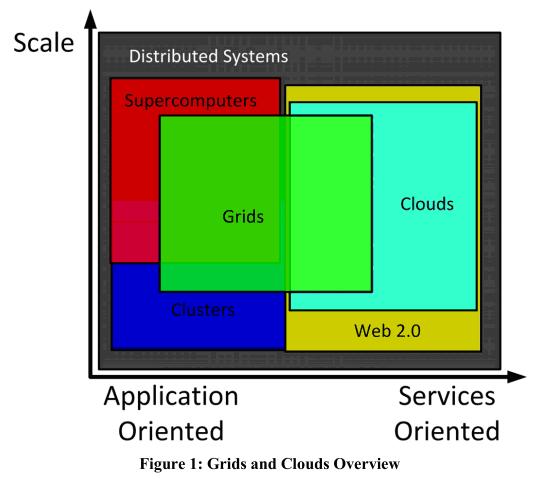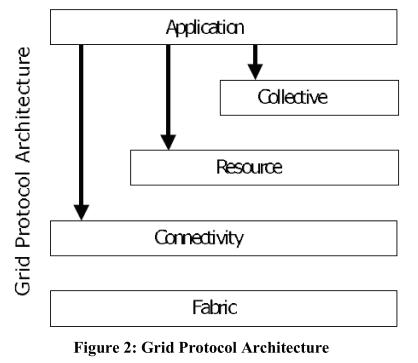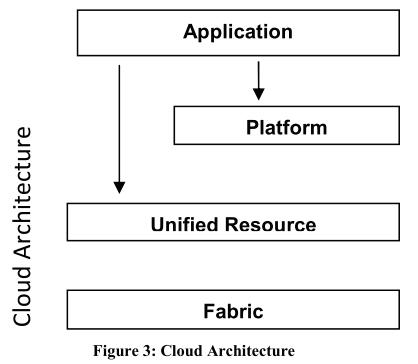[文章摘录]Cloud Computing and Grid Computing 360-Degree Compared (GCE, 2008)
Time: 5.0 hours
I Foster, Y Zhao, I Raicu, S Lu. Cloud Computing and Grid Computing 360-Degree Compared, Grid Computing Environments Workshop, 2008
Ian Foster (Argonne National Laboratory) Homepage Blog
被称为"网格之父", 他的研究导致了高性能分布式计算和并发计算的技术, 工具及算法的发展. 显然是个大大牛.Google Scholar数据显示, 他的论文/图书最高被引用了惊人的5000+次.
Argonne National Laboratory(ANL) 美国阿贡国家实验室
美国政府最老和最大的科学与工程研究实验室之一, 有5个主要的研究领域: 基础科学(包括高性能计算方面的实验和理论工作), 科学设施, 能源资源计划, 环境管理和国家安全.
ANL的诺贝尔奖获得者包括
费米(1938, 利用中子辐射发现新的放射性元素,及慢中子所引起的有关核反应),
Maria Goeppert Mayer(1963, 原子核壳模式取得),
Alexei Abrikosov(2003, 提出在极端低温时物质如何显示其奇异行为理论)
这篇论文从多个角度介绍了Cloud Computing与Grid Computing的异同点.
对于此类介绍性文章, 以文章摘录, 学习为主, 一般不作什么评论(因为讨论的不是具体的技术问题).
以下是本文摘录:
1. 概要比较 (S1)
共同点:
(1) vision(前景): 通过使用第三方运转的东西来reduce cost, increase reliability/flexibility
(2) 面临的问题:
(a) manage large facilities
(b) 定义方法供用户发现/请求/使用中心设备提供的资源
(c)在这些资源上实现高并发计算
区别:
Grid Computing是90年代中提出来的, 10年之后, 许多事情都不同了.
(a) 新的需求来分析海量数据
(b) 操作cluster很昂贵
(c) low-cost vitualization技术的出现
(d) Amazon/Google/Micorsoft等公司已经花费巨资构建了大型商用系统, 包含数十万台电脑.未来只需用一张信用卡即可访问世界各地的这些资源.
(e) 所以, 问题的规模不同 ,解决的方法也大为不同.
2. I Foster对Cloud Computing的定义(S1.1)
"A large-scale distributed computing paradigm (大规模)
that is driven by economies of scale, (由规模经济驱动)
in which a pool of abstracted, virtualized, dynamically-scallable, managed (抽象的, 虚拟化的, 动态可扩展的, 托管的)
computing power, storage, platforms, and services (资源类型: 计算能力, 存储, 平台与服务)
are delivered on demand (按需发布)
to external customers (提供给外部用户)
over the Internet." (通过因特网)
3. Cloud Computing会流行的原因(S1.1)
(1) 硬件的快速发展. 价格降低;计算与存储能力提高;多核体系的出现
(2) 数据量的指数级增长. 如科学仪器测量, 模拟;网上发布与归档.
(3) 服务计算与Web2.0应用的广泛应用.
4. Cloud Computing与Grid Computing以及其他Computing的关系(S1.2)
作者认为: Cloud Computing不仅与Grid Computing有交叉, 事实上, 前者是从后者发展而来, 并且依赖后者做为backbone and infrastructure support.
Grid Computing的关注点是发布存储与计算资源的基础架构.
Cloud Computing的关注点则是基于经济目标, 来发布更多的抽象资源与服务.
Utility Computing: 只是一种商业模式, 类似与供电供水或电话系统.

I Foster认为满足下面3个条件的才叫Grid:
(1) 协调不受集中控制的资源
(2) 使用标准, 开放, 通用目的协议和接口
(3) 重视QoS
其中第一和第二条并不适用于现下的Clouds.
5. 第二章中, 作者从Business Model, Architecture, Resource Management, Programming Model, Application Model, Security Model这5个方面对网格与云进行了详细的比较.
6. Business Model (S2.1)
Cloud: pay on a consumption basis
Grid: projected-oriented. 加入网格后可以访问其他机构提供的资源.
7. Architecture (S2.2)

Grid在5个不同的层提供protocols and services.

Cloud的架构如上, 通常提供3种层次的服务 IaaS, PaaS, SaaS.
关于这两种架构各个layer具体情况, 我看完也还是不太明白, 可参考原文.
8. Resource Management
这部分内容对于理解当前Grids与Clouds面临的挑战极为重要. 占据了2.5页篇幅(总共9页, 不计Reference)
(1) Compute Model
Grid: batch-scheduled compute model, 一般不支持互动应用
Cloud: resources in the Cloud being shared by all users at the same time. 支持互动.
(2) Data Model
作者认为下一代Internet Computing中应包含3个角色: Data, Clouding Computing, Client Computing. 其他data management包括mapping, partitioning, querying, movement, caching replication等.
(3) Data Locality
“Data should be distributed over many computers, and computations must be steered towards the best place to execute in order to minimize the communication costs”
(4) Combing compute and data management
对storage与computational问题分开来解决, 会引起过多data movement, 影响扩展性.
(5) Virtualization
Virtualization最主要的目的是abstraction与encapsulation. Clouds很依赖Virtualization技术. 而在Grids中, 则不是很依赖.
(6) Monitoring
Cloud中进行monitoring不如Grid中这么直接. 在Grid中
Cloud中进行monitoring的重要性低于Grid中.
(7) Provenance
9. Programming Model
Grids中常用的编程模型有MPI(Message Passing Interface), Coordination Language, workflow system, MapReduce等.
Cloud中, mesh-up’s 和scripting(Java Script, PHP, Python等)取代了workflow system..
10. Application System
Grids支持许多种不同的应用, 从HPC(high performance computing)到HTC(high throughput computing).
Cloud中能够支持的应用应该具有以下特性: loosely coupled transaction oriented, likely to be interactive.
对这篇文章是泛泛而读, 目的也只是想了解一下相关知识, 这方面并非我目前关注的重点. 以我现在对Grid与Computing的了解, 要对这篇论文进行彻底的理解也显得比较困难.
I Foster, Y Zhao, I Raicu, S Lu. Cloud Computing and Grid Computing 360-Degree Compared, Grid Computing Environments Workshop, 2008
Ian Foster (Argonne National Laboratory) Homepage Blog
被称为"网格之父", 他的研究导致了高性能分布式计算和并发计算的技术, 工具及算法的发展. 显然是个大大牛.Google Scholar数据显示, 他的论文/图书最高被引用了惊人的5000+次.
Argonne National Laboratory(ANL) 美国阿贡国家实验室
美国政府最老和最大的科学与工程研究实验室之一, 有5个主要的研究领域: 基础科学(包括高性能计算方面的实验和理论工作), 科学设施, 能源资源计划, 环境管理和国家安全.
ANL的诺贝尔奖获得者包括
费米(1938, 利用中子辐射发现新的放射性元素,及慢中子所引起的有关核反应),
Maria Goeppert Mayer(1963, 原子核壳模式取得),
Alexei Abrikosov(2003, 提出在极端低温时物质如何显示其奇异行为理论)
这篇论文从多个角度介绍了Cloud Computing与Grid Computing的异同点.
对于此类介绍性文章, 以文章摘录, 学习为主, 一般不作什么评论(因为讨论的不是具体的技术问题).
以下是本文摘录:
1. 概要比较 (S1)
共同点:
(1) vision(前景): 通过使用第三方运转的东西来reduce cost, increase reliability/flexibility
(2) 面临的问题:
(a) manage large facilities
(b) 定义方法供用户发现/请求/使用中心设备提供的资源
(c)在这些资源上实现高并发计算
区别:
Grid Computing是90年代中提出来的, 10年之后, 许多事情都不同了.
(a) 新的需求来分析海量数据
(b) 操作cluster很昂贵
(c) low-cost vitualization技术的出现
(d) Amazon/Google/Micorsoft等公司已经花费巨资构建了大型商用系统, 包含数十万台电脑.未来只需用一张信用卡即可访问世界各地的这些资源.
(e) 所以, 问题的规模不同 ,解决的方法也大为不同.
2. I Foster对Cloud Computing的定义(S1.1)
"A large-scale distributed computing paradigm (大规模)
that is driven by economies of scale, (由规模经济驱动)
in which a pool of abstracted, virtualized, dynamically-scallable, managed (抽象的, 虚拟化的, 动态可扩展的, 托管的)
computing power, storage, platforms, and services (资源类型: 计算能力, 存储, 平台与服务)
are delivered on demand (按需发布)
to external customers (提供给外部用户)
over the Internet." (通过因特网)
3. Cloud Computing会流行的原因(S1.1)
(1) 硬件的快速发展. 价格降低;计算与存储能力提高;多核体系的出现
(2) 数据量的指数级增长. 如科学仪器测量, 模拟;网上发布与归档.
(3) 服务计算与Web2.0应用的广泛应用.
4. Cloud Computing与Grid Computing以及其他Computing的关系(S1.2)
作者认为: Cloud Computing不仅与Grid Computing有交叉, 事实上, 前者是从后者发展而来, 并且依赖后者做为backbone and infrastructure support.
Grid Computing的关注点是发布存储与计算资源的基础架构.
Cloud Computing的关注点则是基于经济目标, 来发布更多的抽象资源与服务.
Utility Computing: 只是一种商业模式, 类似与供电供水或电话系统.

I Foster认为满足下面3个条件的才叫Grid:
(1) 协调不受集中控制的资源
(2) 使用标准, 开放, 通用目的协议和接口
(3) 重视QoS
其中第一和第二条并不适用于现下的Clouds.
5. 第二章中, 作者从Business Model, Architecture, Resource Management, Programming Model, Application Model, Security Model这5个方面对网格与云进行了详细的比较.
6. Business Model (S2.1)
Cloud: pay on a consumption basis
Grid: projected-oriented. 加入网格后可以访问其他机构提供的资源.
7. Architecture (S2.2)

Grid在5个不同的层提供protocols and services.

Cloud的架构如上, 通常提供3种层次的服务 IaaS, PaaS, SaaS.
关于这两种架构各个layer具体情况, 我看完也还是不太明白, 可参考原文.
8. Resource Management
这部分内容对于理解当前Grids与Clouds面临的挑战极为重要. 占据了2.5页篇幅(总共9页, 不计Reference)
(1) Compute Model
Grid: batch-scheduled compute model, 一般不支持互动应用
Cloud: resources in the Cloud being shared by all users at the same time. 支持互动.
(2) Data Model
作者认为下一代Internet Computing中应包含3个角色: Data, Clouding Computing, Client Computing. 其他data management包括mapping, partitioning, querying, movement, caching replication等.
(3) Data Locality
“Data should be distributed over many computers, and computations must be steered towards the best place to execute in order to minimize the communication costs”
(4) Combing compute and data management
对storage与computational问题分开来解决, 会引起过多data movement, 影响扩展性.
(5) Virtualization
Virtualization最主要的目的是abstraction与encapsulation. Clouds很依赖Virtualization技术. 而在Grids中, 则不是很依赖.
(6) Monitoring
Cloud中进行monitoring不如Grid中这么直接. 在Grid中
Cloud中进行monitoring的重要性低于Grid中.
(7) Provenance
9. Programming Model
Grids中常用的编程模型有MPI(Message Passing Interface), Coordination Language, workflow system, MapReduce等.
Cloud中, mesh-up’s 和scripting(Java Script, PHP, Python等)取代了workflow system..
10. Application System
Grids支持许多种不同的应用, 从HPC(high performance computing)到HTC(high throughput computing).
Cloud中能够支持的应用应该具有以下特性: loosely coupled transaction oriented, likely to be interactive.
对这篇文章是泛泛而读, 目的也只是想了解一下相关知识, 这方面并非我目前关注的重点. 以我现在对Grid与Computing的了解, 要对这篇论文进行彻底的理解也显得比较困难.




